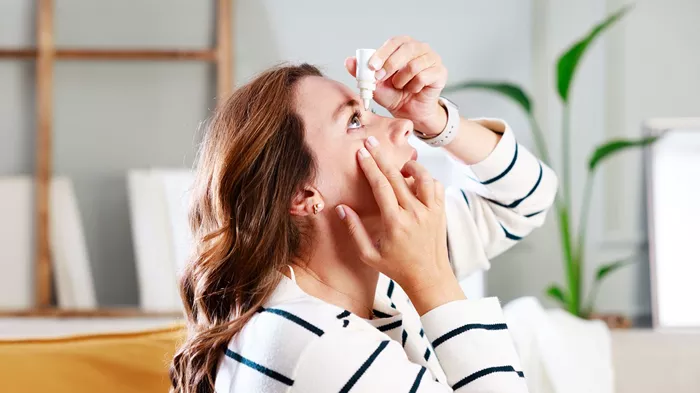This article will provide a comprehensive guide on how to treat conjunctivitis at home. We’ll cover the different types of conjunctivitis, their symptoms, and effective home remedies. Additionally, we’ll discuss when it’s necessary to seek medical attention and preventive measures to avoid recurrence.
Types of Conjunctivitis
Understanding the type of conjunctivitis is crucial for effective treatment. Here are the most common types:
Viral Conjunctivitis
Cause: Often caused by the same viruses that cause the common cold, such as adenoviruses.
Symptoms: Watery discharge, redness, and itching. It usually starts in one eye and can spread to the other.
Duration: Typically lasts 1-2 weeks.
Bacterial Conjunctivitis
Cause: Caused by bacteria such as Staphylococcus or Streptococcus.
Symptoms: Thick, yellow or green discharge, redness, and sometimes swelling. It often affects both eyes.
Duration: Usually resolves in 1-2 weeks with appropriate treatment.
Allergic Conjunctivitis
Cause: Triggered by allergens such as pollen, dust mites, or pet dander.
Symptoms: Redness, itching, and watery discharge, often accompanied by other allergy symptoms like sneezing.
Duration: Can last as long as the allergen is present, but symptoms often improve once the allergen is removed.
Irritant Conjunctivitis
Cause: Caused by exposure to irritants like smoke, chlorine, or shampoo.
Symptoms: Redness and discomfort, with a watery discharge.
Duration: Usually improves once the irritant is removed.
Home Remedies for Conjunctivitis
For mild cases of conjunctivitis, home remedies can provide relief and help the condition resolve more quickly. Here are some effective treatments for each type:
1. Warm Compresses
Warm compresses can help relieve symptoms for both viral and bacterial conjunctivitis.
How to Use: Soak a clean cloth in warm water, wring out the excess, and place it over the closed eyelid. Hold it in place for 5-10 minutes.
Benefits: Helps loosen crusty discharge and soothe the irritation.
2. Cold Compresses
Cold compresses are particularly useful for allergic conjunctivitis.
How to Use: Soak a clean cloth in cold water, wring it out, and place it over the closed eyelid. Hold it in place for 5-10 minutes.
Benefits: Reduces itching and swelling.
3. Saline Rinses
Saline rinses can help cleanse the eye and flush out irritants.
How to Use: Mix 1 teaspoon of salt in 1 cup of warm, boiled water. Use a clean dropper or eye cup to gently rinse the affected eye.
Benefits: Helps remove debris and reduce irritation.
See also: Your Guide to Bacterial Conjunctivitis: How Long Until It Clears Up
4. Artificial Tears
Over-the-counter artificial tears can be used for symptomatic relief, especially in cases of viral and allergic conjunctivitis.
How to Use: Follow the instructions on the product label for frequency and dosage.
Benefits: Provides moisture and helps alleviate dryness and irritation.
5. Avoiding Allergens
For allergic conjunctivitis, avoiding known allergens is crucial.
How to Use: Identify and minimize exposure to allergens such as pollen, pet dander, or dust.
Benefits: Reduces symptoms by addressing the root cause.
6. Good Hygiene Practices
Practicing good hygiene helps prevent the spread of conjunctivitis and speeds up recovery.
How to Use: Wash hands frequently, avoid touching the face, and use separate towels for each person. Disinfect commonly touched surfaces regularly.
Benefits: Reduces the risk of spreading the infection to others and prevents reinfection.
When to Seek Medical Attention
While most cases of conjunctivitis can be managed at home, there are situations where medical attention is necessary. Contact a healthcare provider if:
Symptoms Persist: If symptoms do not improve or worsen after a week of home treatment, seek medical advice.
Severe Symptoms: If there is severe pain, vision changes, or sensitivity to light, consult a healthcare provider.
New Symptoms: If additional symptoms such as a high fever, intense redness, or swelling develop, seek medical care.
Recurrent Infections: If conjunctivitis recurs frequently, a healthcare provider can help identify underlying causes.
Preventive Measures
Preventing conjunctivitis involves maintaining good hygiene and taking steps to avoid irritants and allergens. Here are some preventive tips:
Hand Hygiene: Encourage regular hand washing with soap and water, especially before touching the face or eyes.
Avoid Sharing: Do not share personal items such as towels, pillows, or eye makeup.
Protect Eyes: Wear protective eyewear in environments where irritants or allergens are present.
Manage Allergies: Use air filters and keep windows closed during high pollen seasons. Consider allergy medications if needed.
Conclusion
Conjunctivitis, or pink eye, is a common condition that can be treated effectively at home with the right remedies and practices. By understanding the different types of conjunctivitis and their symptoms, you can choose the appropriate home treatment and take steps to alleviate discomfort. Warm and cold compresses, saline rinses, and artificial tears are useful tools for managing symptoms, while good hygiene and allergen avoidance can prevent and reduce recurrence.
Remember that while home treatments are often sufficient, it’s important to monitor the condition and seek medical attention if necessary. With proper care and preventive measures, conjunctivitis can be managed effectively, allowing you and your family to enjoy clear, healthy eyes.
Related articles:
Dry Eyes Is A Symptom Of What?
Multiple Styes in One Eye: Causes, Risks, Treatment & Prevention


